Last updated: August 7, 2025
Article
Climate and Water Monitoring at Guadalupe Mountains National Park: Water Year 2023
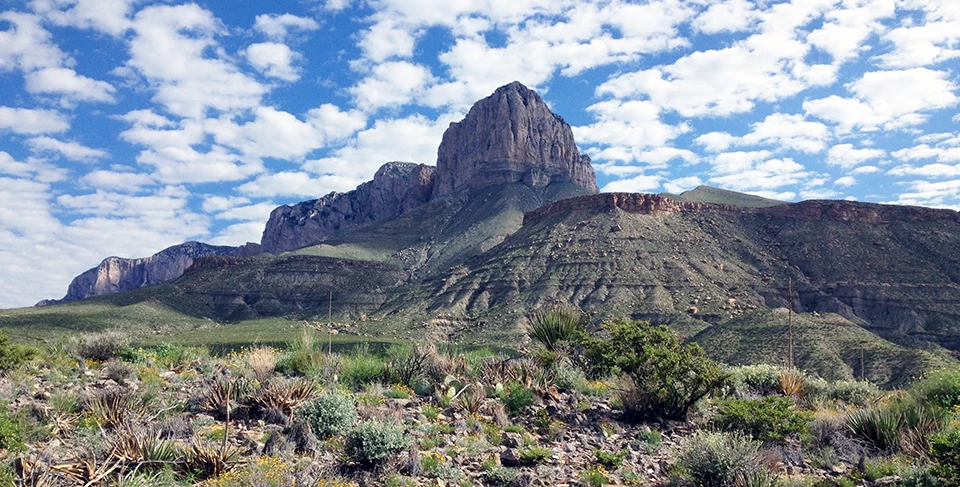
NPS
Overview
Together, climate and hydrology shape ecosystems and the services they provide, particularly in arid and semi-arid ecosystems. Understanding changes in climate, groundwater, and surface water is key to assessing the condition of park natural resources—and often, cultural resources.
At Guadalupe Mountains National Park (Figure 1), Chihuahuan Desert Inventory and Monitoring Network scientists study how ecosystems may be changing by taking measurements of key resources, or “vital signs,” year after year—much as a doctor keeps track of a patient’s vital signs. This long-term ecological monitoring provides early warning of potential problems, allowing managers to mitigate them before they become worse. At Guadalupe Mountains National Park, we monitor climate, groundwater, and springs, among other vital signs.
Surface water and groundwater conditions are closely related to climate conditions. Because they are better understood together, we report on climate in conjunction with water resources. Reporting is by water year (WY), which begins in October of the previous calendar year and goes through September of the water year (e.g., WY2023 runs from October 2022 through September 2023). This web report presents the results of climate and water monitoring at Guadalupe Mountains National Park in WY2023.

NPS
Climate and Weather
There is often confusion over the terms “weather” and “climate.” In short, weather describes instantaneous meteorological conditions (e.g., it’s currently raining or snowing, it’s a hot or frigid day), and climate reflects patterns of weather at a given place over longer periods of time (seasons to years). Climate is the primary driver of ecological processes on Earth. Climate and weather information provide context for understanding the status or condition of other park resources.
Methods
We report on three Remote Automated Weather Stations (RAWS) at Guadalupe Mountains National Park (Figure 1). Dog Canyon RAWS (#DGCT2) at an elevation of 6,262 ft (1,909 m) has been operational since 2010. Pinery Texas RAWS (#PSGT2) at an elevation of 5,381 feet (1,640 m) has been operational since 2001. PX Well RAWS (#PXWT2) at an elevation of 3,873 feet (1,181 m) has been operational since 2010. These stations provide reliable climate datasets used for analyses in this climate and water report. Data from these stations are accessible through Climate Analyzer.

NPS
Results
For precipitation and temperature monitoring results, scroll down or click on a weather station here:
Precipitation and Air Temperature—Dog Canyon (RAWS)
Annual precipitation at Dog Canyon in WY2023 was 15.17″ (38.5 cm), which was 2.90″ (7.4 cm) less than the 2011–2020 average. Precipitation totals in October, January, February, and August were two to three times the average amount. Amounts of precipitation in November and May were similar to average. All other months received substantially less moisture than average, including some months with no precipitation (March and April). Extreme daily rainfall events (≥ 1.00″; 2.54 cm) occurred on one day, which is a quarter of the 2011–2020 average annual frequency of 4.2 days. The extreme rainfall event was on 23 August 2023 (3.52″; 8.9 cm). Monthly precipitation in WY2023 is displayed in Figure 2.
The mean annual maximum temperature at Dog Canyon in WY2023 was 68.5°F (20.3°C), 0.1°F (0.05°C) above the 2011–2020 average. The mean annual minimum temperature in WY2023 was 46.9°F (8.3°C), 0.2°F (0.1°C) below the 2011–2020 average. Mean monthly maximum and minimum temperatures in WY2023 were within 2.6°F (1.4°C) of the 2011–2020 averages for most of the year, with a few exceptions: October and November mean maximum temperatures were 4.9°F (2.7°C) and 5.6°F (3.1°C) cooler than average, respectively, and July and September mean maximum temperatures were 5.5°F (3.1°C) and 5.8°F (3.2°C) warmer than average, respectively. Compared to the maximums, mean monthly minimum temperatures generally showed smaller deviations from the averages throughout the year. Extremely hot temperatures (≥ 89.0°F; 31.7°C) occurred on 43 days in WY2023, twice the average frequency of 21.6 days. Extremely cold temperatures (≤ 24.0°F; −4.4°C) occurred on 21 days, the same as the average frequency of 21.6 days. The mean monthly maximum and minimum temperatures in WY2023 are displayed in Figure 2.
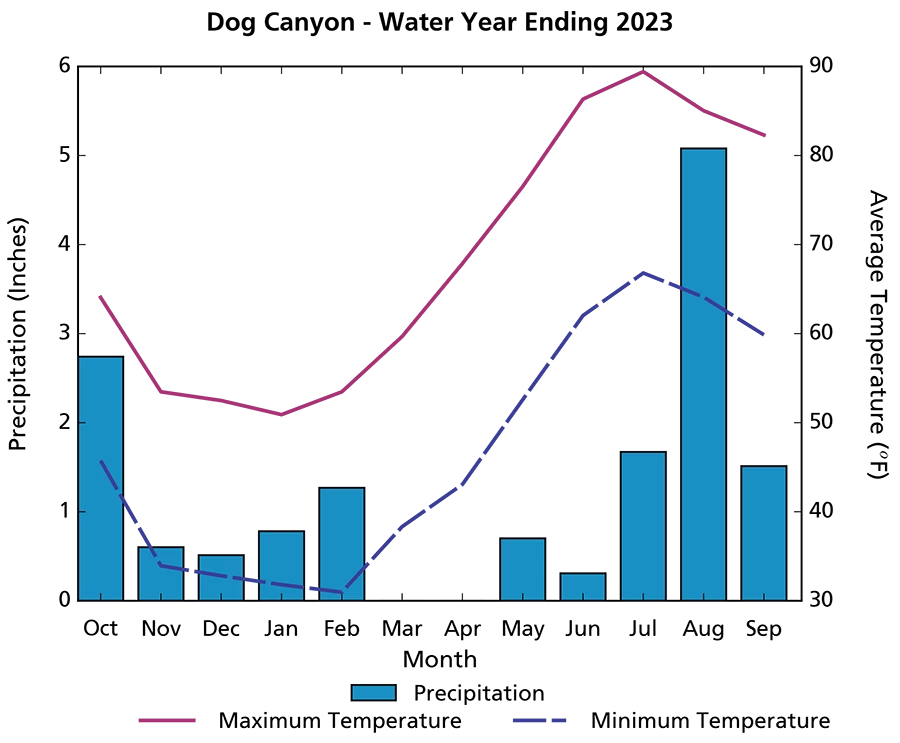
NPS
Precipitation and Air Temperature—Pinery Texas (RAWS)
Annual precipitation at Guadalupe Mountains National Park at Pinery Texas in WY2023 was 11.31″ (28.7 cm), 5.43″ (13.8 cm) less than the 2001–2020 average. October and February precipitation totals were respectively over three and two times the 2001–2020 averages. Amounts of precipitation in January and August were similar to the monthly averages. The remaining eight months received substantially less moisture than the long-term averages, including some months with no precipitation (March, April, and May). Extreme daily rainfall events (≥ 1.00″, 2.54 cm) occurred on 2 days, half the average annual frequency of 3.6 days. Extreme rainfall events occurred on 02 October 2022 (1.73″, 4.4 cm) and 23 August 2023 (1.59″, 4.0 cm). Monthly precipitation in WY2023 is displayed in Figure 3.
The mean annual maximum temperature at Pinery Texas in WY2023 was 71.7°F (22.1°C), 0.4°F (0.2°C) above the 2001–2020 average. The mean annual minimum temperature in WY2023 was 52.5°F (11.4°C), 0.4°F (0.2°C) above the 2001–2020 average. Mean monthly maximum and minimum temperatures in WY2023 were generally similar to or below the 2001–2020 averages by up to 5.6°F (3.1°C) for the first part of the year (October–April). Temperatures in the latter part of the water year (May–September) were warmer than average by up to 7.2°F (4.0°C). Extremely hot temperatures (≥ 92.0°F, 33.3°C) occurred on 49 days in WY2023, over twice the average frequency of 21.5 days. Extremely cold temperatures (≤ 27.0°F, −2.8°C) occurred on 22 days, similar to the average frequency of 20.5 days. The mean monthly maximum and minimum temperatures in WY2023 are displayed in Figure 3.
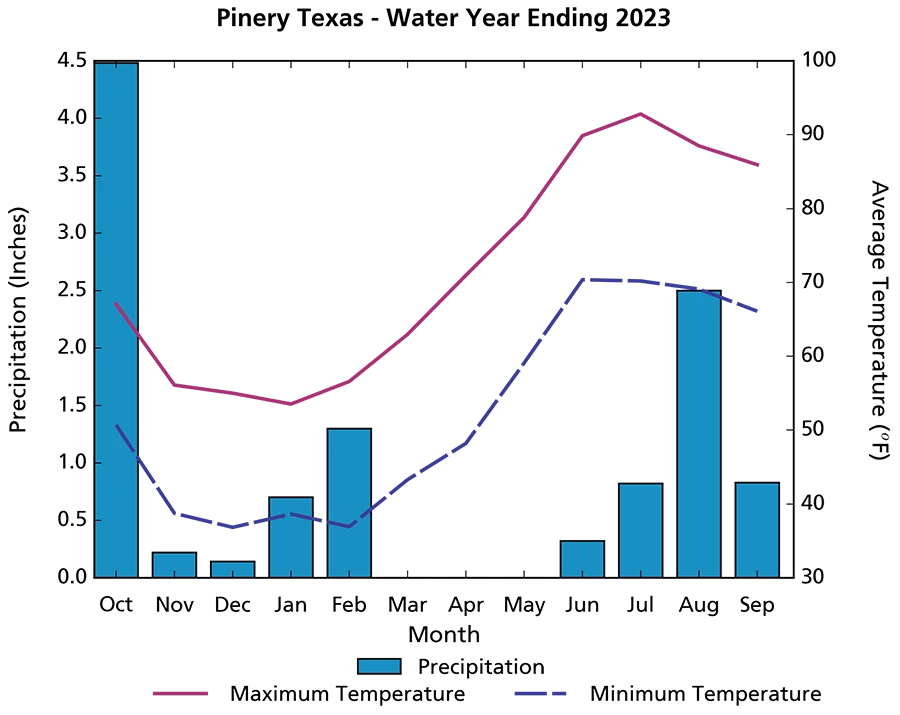
NPS
Precipitation and Air Temperature—PX Well (RAWS)
Annual precipitation at PX Well in WY2023 was 4.78″ (12.1 cm), 6.39″ (16.2 cm) less than the 2010–2020 annual average. Compared to the 2010–2020 averages, January precipitation was over two and half times greater and May precipitation was over one and a half times greater. Precipitation totals for October and August were similar to the monthly averages. The remaining eight months received substantially less moisture than average, including one month with no precipitation (April). No extreme daily rainfall events (> 1.00″; 2.54 cm) occurred in WY2023, which is less than the 2010–2020 average annual frequency of 1.3 days. Monthly precipitation in WY2023 is displayed in Figure 4.
The mean annual maximum temperature at PX Well in WY2023 was 80.4°F (26.9°C), 0.5°F (0.3°C) above the 2010–2020 average. The mean annual minimum temperature in WY2023 was 54.2°F (12.3°C), 0.3°F (0.1°C) below the 2010–2020 average. Mean monthly maximum and minimum temperatures in WY2023 were within 2.5°F (1.4°C) of the 2010–2020 averages for most of the year. Notable exceptions were November, when the mean maximum temperature was 5.8°F (3.2°C) cooler than average, and July and September, when the mean maximum temperatures were substantially warmer than average—6.3°F (3.5°C) and 7.0°F (3.9°C) warmer, respectively. Throughout the year, mean monthly minimum temperatures were closer to the long-term averages than mean monthly maximum temperatures were. Extremely hot temperatures (≥ 102.0°F; 38.9°C) occurred on 46 days in WY2023, over twice the average frequency of 19 days. Extremely cold temperatures (≤ 29.0°F; −1.7°C) occurred on 23 days, similar to the average frequency of 22.4 days. The mean monthly maximum and minimum temperatures in WY2023 are displayed in Figure 4.
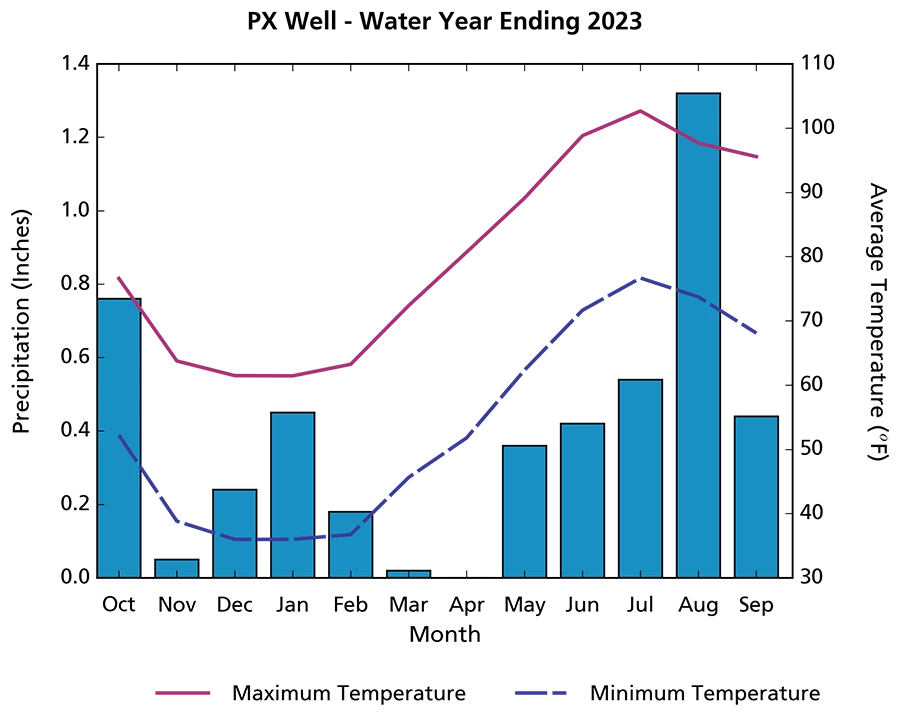
NPS
Drought
Reconnaissance drought index (Tsakiris and Vangelis 2005) provides a measure of drought severity and extent relative to the long-term climate. It is based on the ratio of average precipitation to average potential evapotranspiration (the amount of water loss that would occur from evaporation and plant transpiration if the water supply was unlimited) over short periods of time (seasons to years). The reconnaissance drought index for the three stations at Guadalupe Mountains National Park indicate that WY2023 was drier than the average for each station, from the perspective of both precipitation and potential evapotranspiration (Figure 5, Figure 6, and Figure 7).
Reference: Tsakiris G., and H. Vangelis. 2005. Establishing a drought index incorporating evapotranspiration. European Water 9: 3–11.
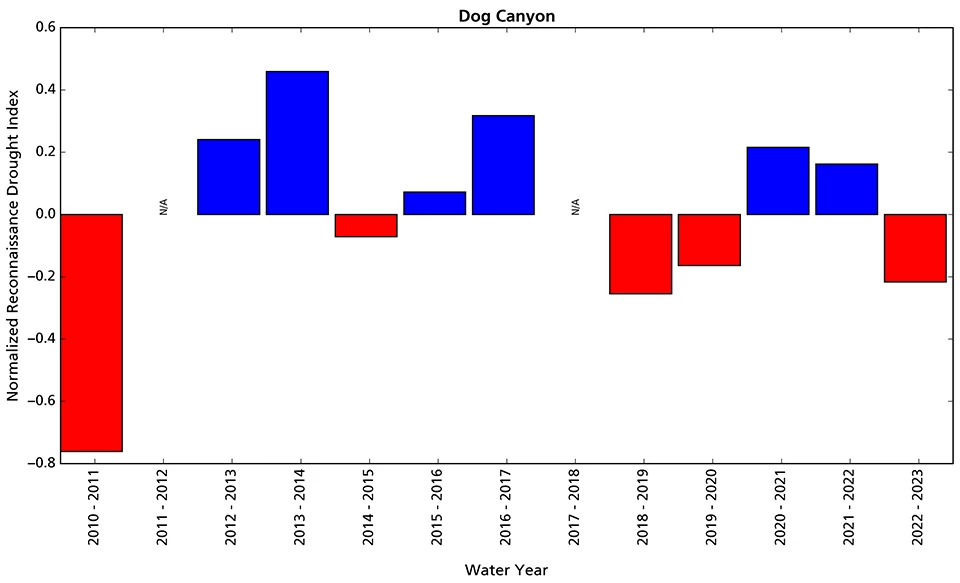
NPS
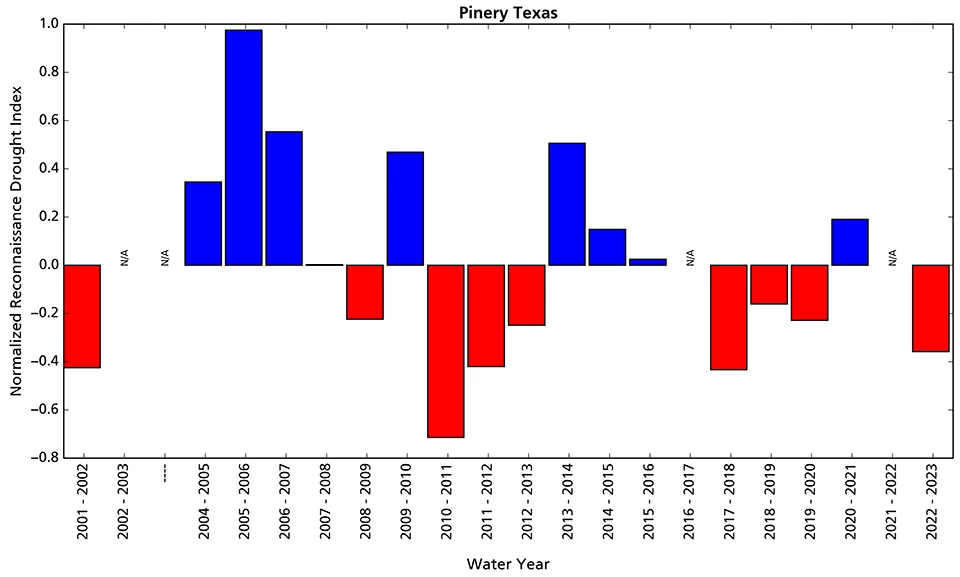
NPS
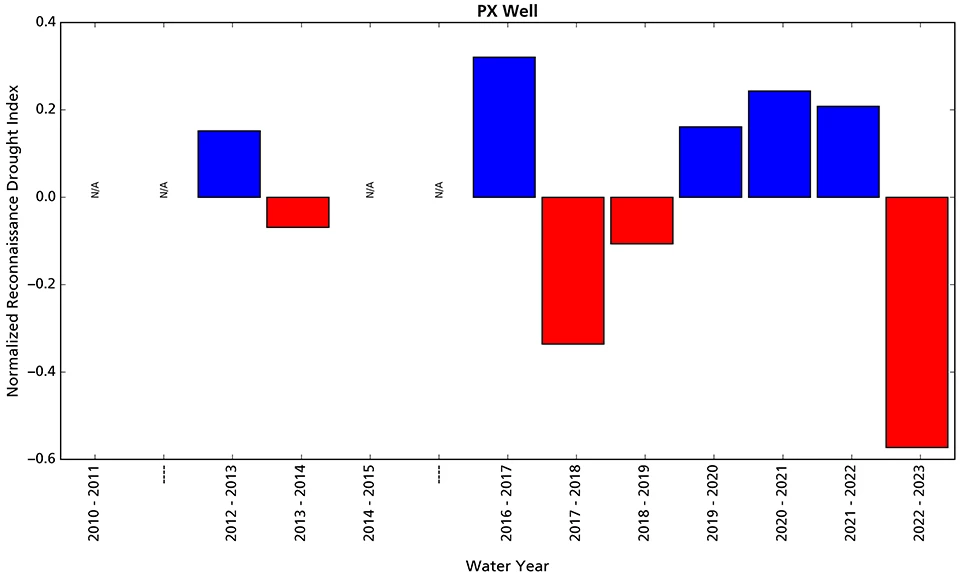
NPS
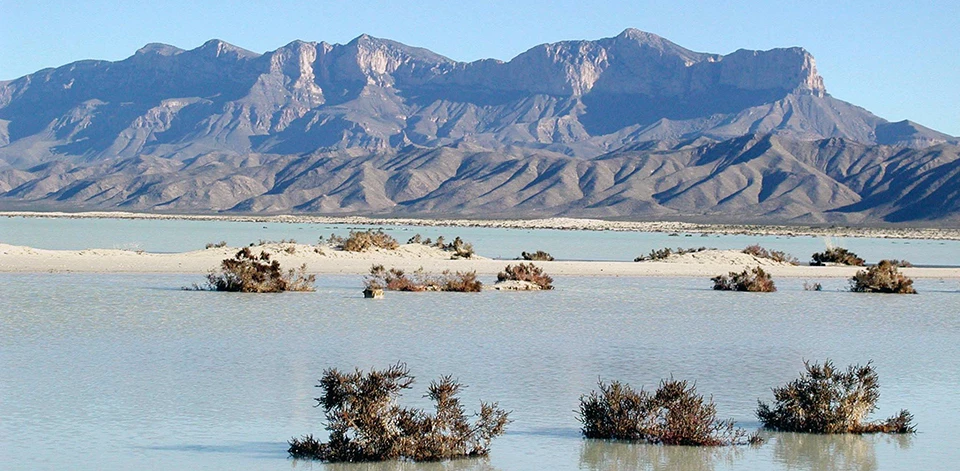
NPS
Groundwater
Groundwater is one of the most critical natural resources of the American Southwest. It provides drinking water, irrigates crops, and sustains rivers, streams, and springs throughout the region.
Methods
Guadalupe Mountains National Park groundwater is monitored in three wells: Lemonade, PX, and Signal Peak wells (Figure 1). The Chihuahuan Desert Network has monitored the wells using automated methods since WY2010.
Results
Groundwater monitoring results for WY2023 are summarized in Table 1. Mean depth to water at Lemonade well in WY2023 was 29.16 ft (8.89 m) below ground surface (bgs), slightly higher than the previous year. Earlier in the monitoring record, the water level at Lemonade well was affected by leaking pipes and nearby groundwater pumping, causing temporary increases and decreases. Outside those periods, the water level has been relatively stable and shallow (Figure 8).
The groundwater level in PX well has been gradually declining since monitoring began in 2010 and was likely dry during WY2023 (Figure 9). A manual measurement at PX well on 12 December 2022 found dry conditions and the sensor data do not indicate any substantial increases or decreases during the water year. In 2016, the total well depth was 285.00 ft bgs (86.87 m bgs). However, site visits in 2020, 2021, and 2022 found mud or gypsum sand on the sounder or deployed sensor. This may indicate that the well was filling in with sediment, effectively decreasing the well depth. The well bottom is currently estimated to be at approximately 280.50 ft bgs (85.50 m bgs).
Automated sensor data from Signal Peak is only available for 01 October 2022 to 06 January 2023 because of equipment malfunction. The mean depth to water during that period was 1,142.74 ft bgs (348.31 m bgs). A manual measurement made in September 2023 was 1,161.16 ft bgs (353.92 m bgs), indicating a decline of over 18 ft (> 5.5 m) in less than nine months. The groundwater level in Signal Peak well has gradually declined since monitoring began in WY2010; however, the decline in WY2023 is much steeper than previously observed (Figure 10). Additional monitoring is needed to understand this rapid change.
Table 1. Groundwater monitoring results in water year (WY) 2023, Guadalupe Mountains National Park. NA = not able to calculate; amsl = above mean sea level; bgs = below ground surface.
| Well Name | State Well Number | Wellhead Elevation (ft amsl) |
Mean Depth to Water (ft bgs) |
Mean Water Level Elevation (ft amsl) |
Change in Elevation from WY2021 (± ft) |
Elevation Change (± ft) from Earliest Recorded Water Level (year) |
|---|---|---|---|---|---|---|
| Lemonade | 4808904 | 3,635 | 29.08 | 3,605.92 | +0.08 | −2.75 (2010) |
| PX Well | 4701201 | 3,867 | dry | dry | NA | NA |
| Signal Peak | 4710201 | 4,799 | 1,142.74 | 3,656.26 | −1.22 | −12.84 (1978) |
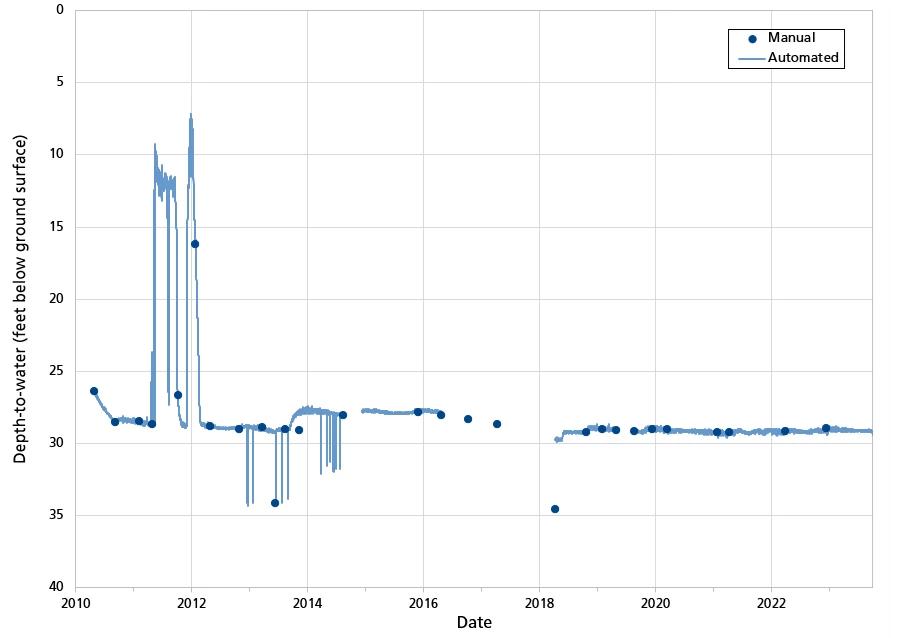
NPS
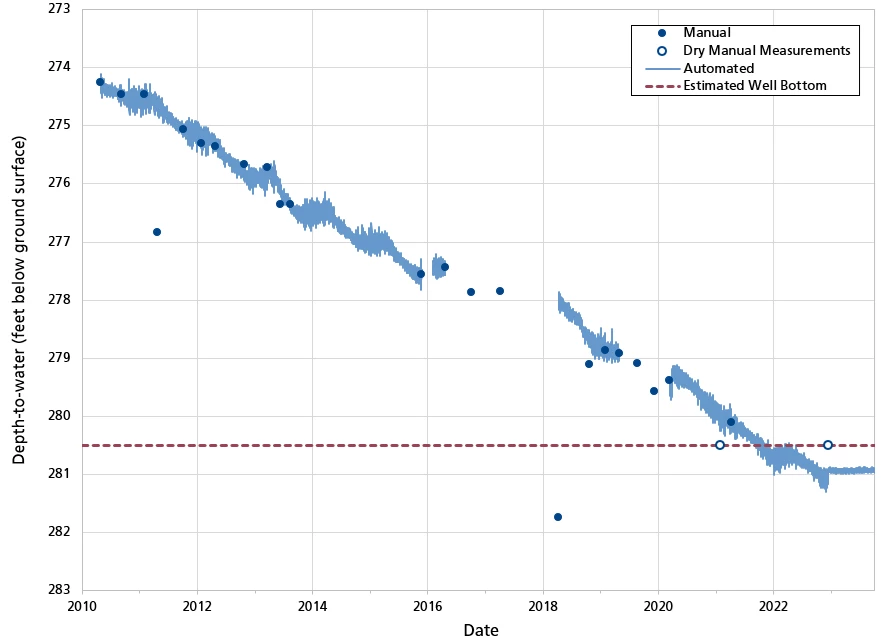
NPS

NPS
Springs
Background
Springs, seeps, and tinajas (small pools in a rock basin or impoundments in bedrock) are small, relatively rare biodiversity hotspots in arid lands. They are the primary connection between groundwater and surface water and are important water sources for plants and animals. For springs, the most important questions we ask are about persistence (How long was there water in the spring?) and water quantity (How much water was in the spring?). Springs reporting is by water year (WY), which begins in October of the previous calendar year and goes through September of the current calendar year (e.g., WY2023 runs from October 2022 through September 2023). WY2023 springs sampling at Guadalupe Mountains National Park occurred between 17 March and 20 March 2023. Water persistence is monitored continuously throughout the water year, but in this report we only present WY2023 persistence data up to the springs sampling visit date.
Methods
Chihuahuan Desert Network springs monitoring is organized into the four modules described below.
Site Characterization
This module provides context for interpreting change in the other modules. We record GPS locations, draw a site diagram, and describe the spring type (e.g., helocrene, limnocrene, rheocrene, or tinaja) and its associated vegetation in this module. Helocrene springs emerge as low-gradient wetlands, limnocrene springs emerge as pools, and rheocrene springs emerge as flowing streams. This module is completed once every five years or after significant events.
Site Condition
We estimate the level of natural and anthropogenic disturbances and the level of stress on vegetation and soils at the spring on a scale of 1–4, where 1 = undisturbed, 2 = slightly disturbed, 3 = moderately disturbed, and 4 = highly disturbed. Types of natural disturbances can include flooding, drying, fire, wildlife impacts, windthrow of trees and shrubs, beaver activity, and insect infestations. Anthropogenic disturbances can include roads, off-highway vehicle trails, hiking trails, livestock and feral-animal impacts, removal of invasive non-native plants, flow modification, and other evidence of human use of the spring site. We take repeat photographs from the same location and perspective to show the spring and its landscape context. We note the presence of certain obligate wetland plant species (plant species that almost always occur only in wetlands), facultative wetland plant species (plant species that usually occur in wetlands but also occur in other habitats), and invasive non-native crayfish and bullfrogs (American bullfrog [Lithobates catesbeianus]). We also record the density of invasive non-native plants using a qualitative scale (1–5 plants, scattered patches, evenly distributed patches, or a matrix).
Water Quantity
We measure the persistence of surface water, amount of spring discharge, and wetted extent (area that contained water). To estimate persistence, we analyze the variance of temperature measurements taken by logging thermometers placed at or near the orifice (spring opening). Because water mediates variation in diurnal temperatures, data from a submerged sensor will show less daily variation than data from an exposed, open-air sensor; this tells us when the spring was wet or dry. Surface discharge is measured with a timed sample of water volume. Wetted extent is a systematic measurement of the physical length (up to 100 m), width, and depth of surface water. It is assessed using a technique for either standing water (e.g., limnocrene and helocrene springs) or flowing water (e.g., rheocrene springs).
Water Quality
We measure core water quality and water chemistry parameters. Core water quality parameters include water temperature, pH, specific conductivity (a measure of dissolved compounds and contaminants), dissolved oxygen (how much oxygen is present in the water), and total dissolved solids (an indicator of potentially undesirable compounds). Discrete measurements of these parameters are collected with a multiparameter meter. If the meter fails calibration checks, we do not present data. Water chemistry is assessed by collecting surface water sample(s) and estimating the concentration of major ions with a photometer in the field. These parameters are collected at one or more sampling locations within a spring. Data are presented only for the primary sampling location within each spring. Each perennial spring is somewhat unique, and Texas has not adopted water quality standards that would apply across the diversity of springs described here. Ongoing, long-term data collection at each spring will improve our understanding of the natural range in water quality and water chemistry parameters for a given site.
List of Springs
Scroll down or click on a spring below to view monitoring results.
Bone Spring ǀ Dog Canyon Spring ǀ Guadalupe Spring ǀ Smith Spring ǀ Upper Pine Spring
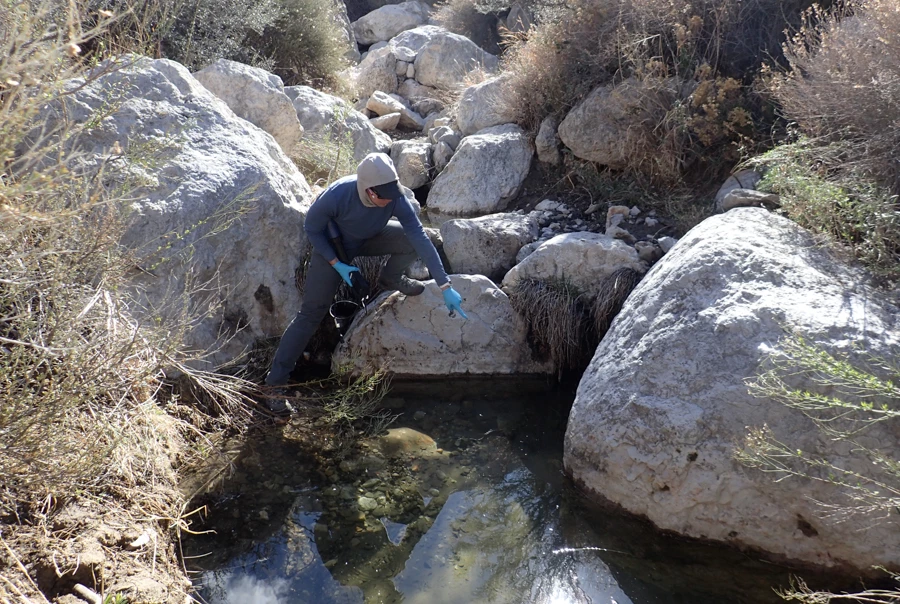
NPS
Bone Spring
Bone Spring (Figure 11) is a rheocrene spring (a spring that emerges into one or more stream channels). The spring emerges in a boulder-strewn wash below the base of the western escarpment of the Guadalupe Mountains. The spring initially forms stagnant pools, but flow increases after about 15 m and forms a flowing stream interspersed with pools for approximately 200 m. The spring was not visited during WY2023 due to access challenges but remains a sentinel site for annual monitoring.
Site Condition
The spring was not visited during WY2023 so there is no information on site condition.
Water Quantity
The spring was not visited so there is no estimate of persistence for WY2023. Persistence data from April 2018 through March 2022 are presented in Figure 12.
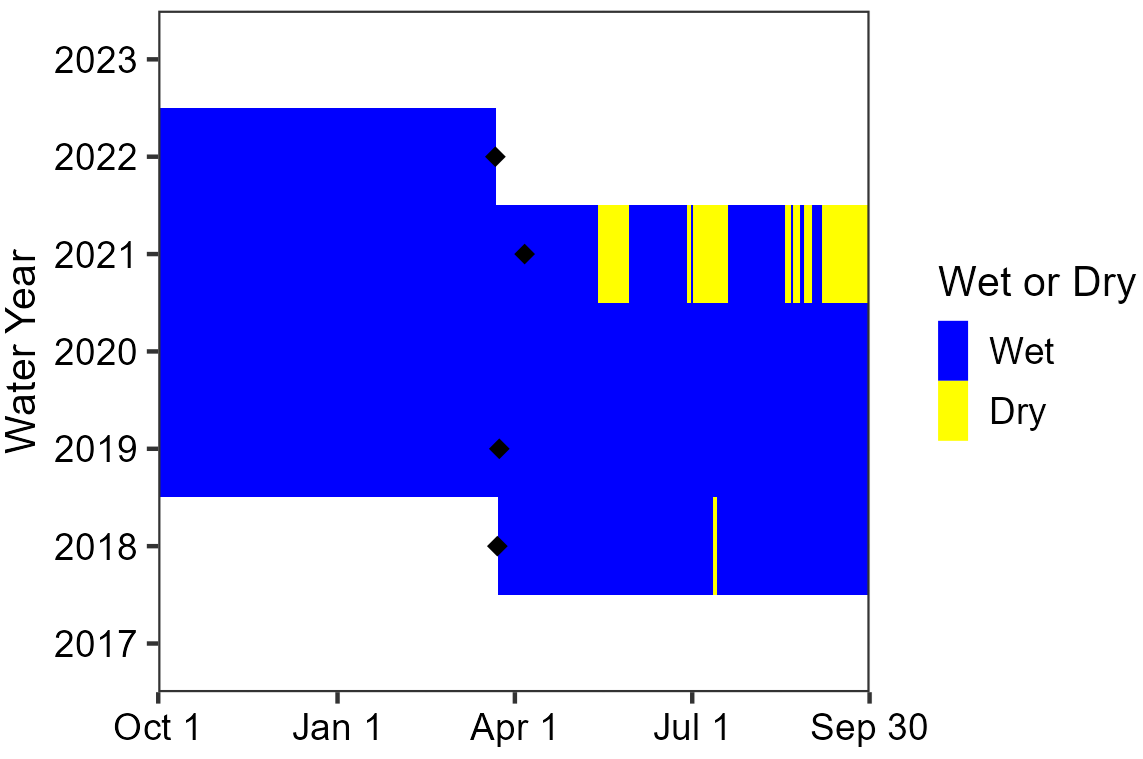
NPS
The spring was not visited during WY2023 so there is no information on discharge. In past years (2018–2022), mean discharge measurements ranged from 4.5 to 8.7 L/min (1.2–2.3 gal/min) at Bone Spring (Table 2).
The spring was not visited during WY2023 so there is no information on wetted extent. Previously (2018–2022), springbrook length was consistently 100 m (328 ft) or greater. Average width and depth ranged from 104.3–150.6 cm (41.1–59.3 in) and 5.3–12.7 cm (2.1–5.0 in), respectively (Table 3).
Water Quality
The spring was not visited during WY2023. Past results (2018–2022) are summarized in Table 4 and Table 5.
Bone Spring Data Tables
| Sampling Location | WY2023 Mean (range of prior means) |
Prior Years Measured (# of visits with measurements) |
|---|---|---|
| 002 | c.n.s. (4.5–8.7) | 2018–2022 (4) |
| Measurement | WY2023 Value (range of prior values/means) |
Prior Years Measured (# of visits with measurements) |
|---|---|---|
| Width (cm) | c.n.s. (104.3–150.6) | 2018–2022 (4) |
| Depth (cm) | c.n.s. (5.3–12.7) | 2018–2022 (4) |
| Length (m) | c.n.s. (100) | 2018–2022 (4) |
| Sampling Location | Measurement Location | Parameter | WY2023 Value (range of prior values) |
Prior Years Measured (# of measurements) |
|---|---|---|---|---|
| 001 | Center | Dissolved oxygen (mg/L) | c.n.s. (4.69–9.05) |
2018–2022 (4) |
| 001 | Center | pH | c.n.s. (7.56–8.15) |
2018–2022 (4) |
| 001 | Center | Specific conductivity (µS/cm) | c.n.s. (1,063–1,163) |
2018–2022 (4) |
| 001 | Center | Temperature (°C) | c.n.s. (6.2–14.6) |
2018–2022 (6) |
| 001 | Center | Total dissolved solids (mg/L) | c.n.s. (689–756) |
2018–2022 (4) |
| Sampling Location | Measurement Location | Parameter | WY2023 Value (range of prior values) |
Prior Years Measured (# of measurements) |
|---|---|---|---|---|
| 001 | Center | Alkalinity (CaCO3) |
c.n.s. (205–250) |
2018–2022 (4) |
| 001 | Center | Calcium (Ca) |
c.n.s. (70–120) |
2018–2022 (4) |
| 001 | Center | Chloride (Cl) |
c.n.s. (8–19) |
2018–2022 (4) |
| 001 | Center | Magnesium (Mg) |
c.n.s. (40–95) |
2018–2022 (4) |
| 001 | Center | Potassium (K) |
c.n.s. (0.8–1.4) |
2018–2022 (4) |
| 001 | Center | Sulphate (SO4) |
c.n.s. (185–380) |
2018–2022 (4) |
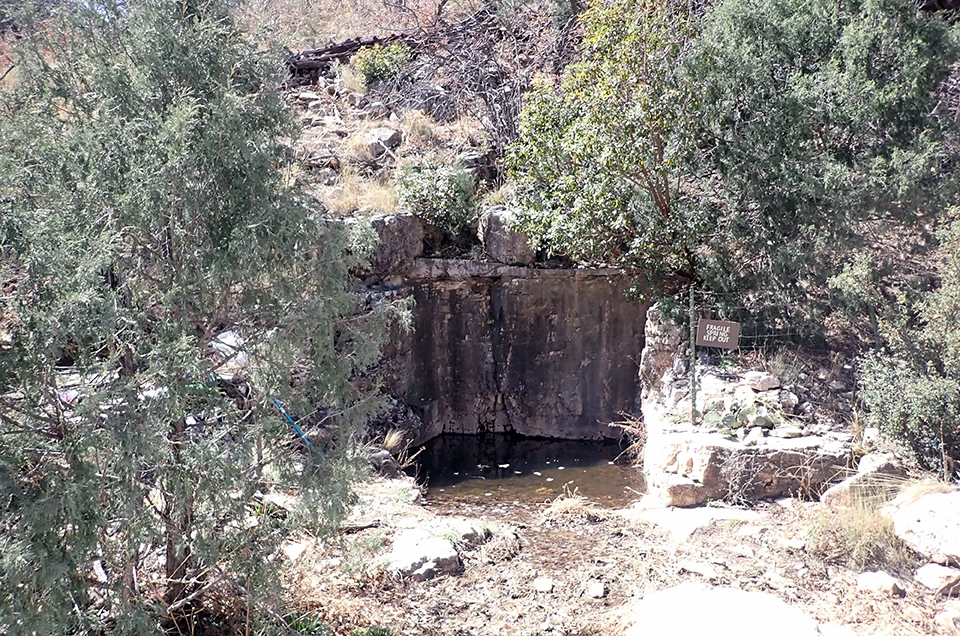
NPS
Dog Canyon Spring
Dog Canyon Spring (Figure 13) is a limnocrene spring (a spring that emerges to form one or more stagnant pools). The spring emerges from a hillslope to form a 4 x 3 m pool at the edge of a dry wash. The pool is between 0.5 and 1.0 m deep and is bounded on three sides by rock walls. The northwest edge (facing the drainage) has a flat shore easily accessible by wildlife. The WY2023 visit occurred on 19 March 2023, and the spring was wetted (contained water).
Site Condition
In WY2023, we rated Dog Canyon Spring (Figure 14) slightly disturbed by contemporary human use because of a fence surrounding the spring on three sides (rated undisturbed to moderately disturbed in the past); slightly disturbed by flow modification related to the square stone walls that were cut on three sides (rated undisturbed to highly disturbed in the past); and slightly disturbed by wildlife based on tracks along the banks surrounding the spring (rated moderately disturbed in the past). No other natural or human-caused disturbances were observed at Dog Canyon Spring in WY2023.
As in past years, we did not observe invasive non-native crayfish or American bullfrog (Lithobates catesbeianus) at Dog Canyon Spring in WY2023. We observed one invasive non-native plant species at the spring: 1–5 common mullein plants (Verbascum thapsus, scattered patches observed in 2017).
As in past years, we did not observe any obligate/facultative wetland plants at Dog Canyon Spring in WY2023.
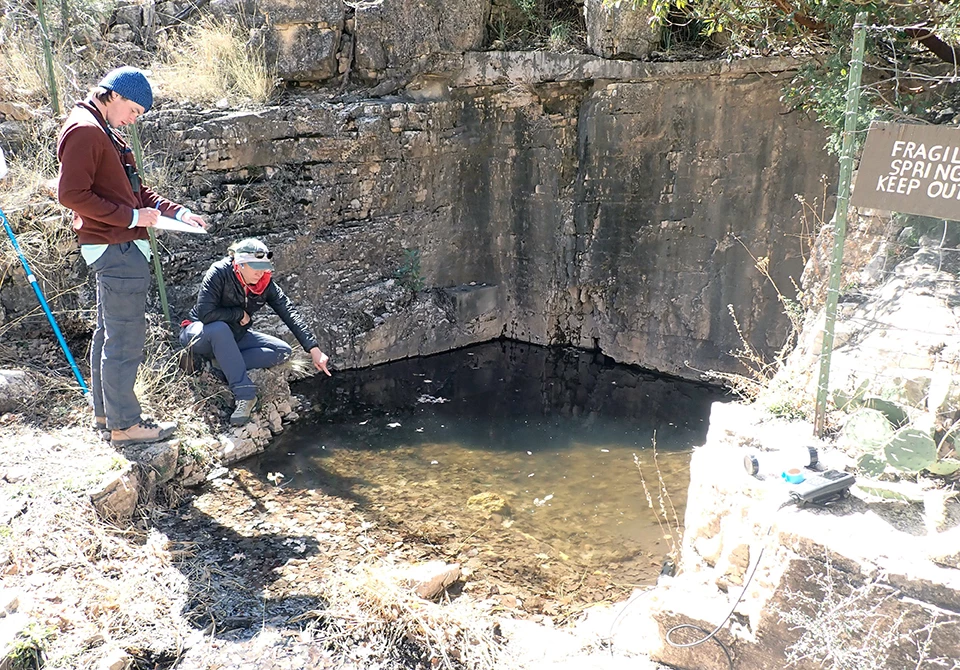
NPS
Water Quantity
Sensors are deployed and data are downloaded during our annual visit, which takes place in the middle of the water year; the dates of these visits are indicated by black diamonds in the persistence graph (Figure 15). The temperature sensor indicated that Dog Canyon Spring was wetted for 170 of 170 days (100%) measured up to the WY2023 visit. In prior water years, the spring was wetted 57.8–100% of the days measured across entire water years.
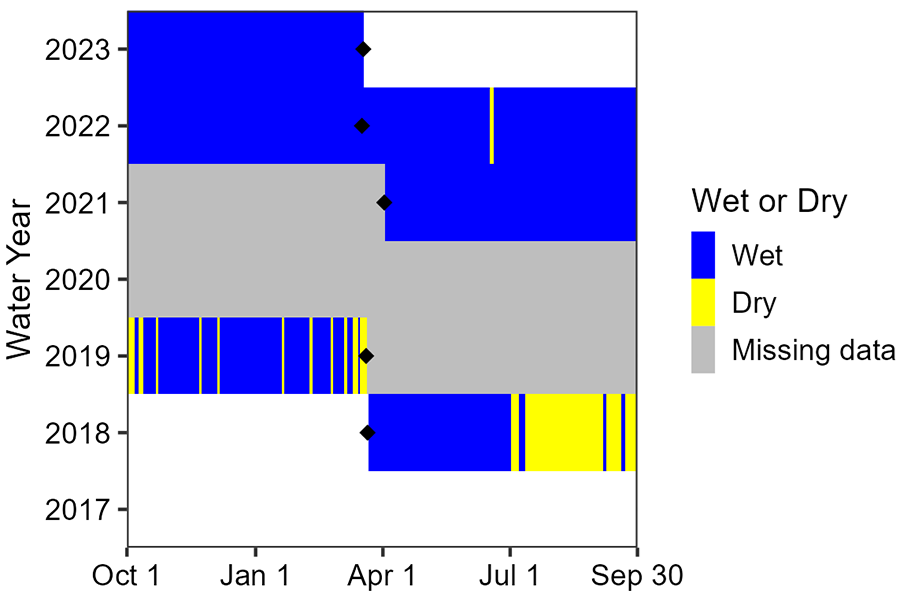
NPS
As in past years, there was no measurable discharge from the pool in WY2023.
Wetted extent was evaluated using a method for standing water in WY2023. Width averaged 3.4 m (11.2 ft), length averaged 4.5 m (14.8 ft), and depth averaged 56.3 cm (22.2 in). Overall, length, width, and depth of the spring were similar to ranges of values from prior years (Table 6).
Water Quality
Core water quality (Table 7) and water chemistry (Table 8) data were collected at the primary sampling location (Figure 14). In WY2023, values for specific conductivity, temperature, and total dissolved solids were within the ranges of values recorded in prior years, while dissolved oxygen was higher than previously observed. The pH sensor failed a calibration check, so pH data are not available for the WY2023 visit. Values for chloride, magnesium, potassium, and sulphate were similar to previous measurements, while alkalinity and calcium levels were higher than observed in the past.
Dog Canyon Spring Data Tables
| Measurement | WY2022 Mean (range of prior means) |
Prior Years Measured (# of visits with measurements) |
|---|---|---|
| Width (m) | 3.4 ± 1.7 (2.9–3.5) | 2018–2022 (4) |
| Depth (cm) | 56.3 ± 12.7 (31.7–93.5) | 2018–2022 (4) |
| Length (m) | 4.5 ± 1.7 (2.7–4.5) | 2018–2022 (4) |
| Sampling Location | Measurement Location | Parameter | WY2023 Value (range of prior values) |
Prior Years Measured (# of measurements) |
|---|---|---|---|---|
| 001 | Center | Dissolved oxygen (mg/L) | 9.01 (1.65–6.07) |
2018–2022 (8) |
| 001 | Center | pH | n.d. (7.44–7.77) |
2018–2022 (8) |
| 001 | Center | Specific conductivity (µS/cm) | 601.0 (571.7–623.0) |
2018–2022 (8) |
| 001 | Center | Temperature (°C) | 5.2 (4.1–8.0) |
2018–2022 (14) |
| 001 | Center | Total dissolved solids (mg/L) | 391.0 (371.8–405.0) |
2018–2022 (8) |
| Sampling Location | Measurement Location | Parameter | WY2023 Value (range of prior values) |
Prior Years Measured (# of measurements) |
|---|---|---|---|---|
| 001 | Center | Alkalinity (CaCO3) |
400 (310–330) |
2018–2022 (4) |
| 001 | Center | Calcium (Ca) |
52 (46–48) |
2018–2022 (4) |
| 001 | Center | Chloride (Cl) |
2 (0–34) |
2018–2022 (4) |
| 001 | Center | Magnesium (Mg) |
55 (45–70) |
2018–2022 (4) |
| 001 | Center | Potassium (K) |
0.8 (0.4–1.6) |
2018–2022 (4) |
| 001 | Center | Sulphate (SO4) |
8 (0–9) |
2018–2022 (4) |
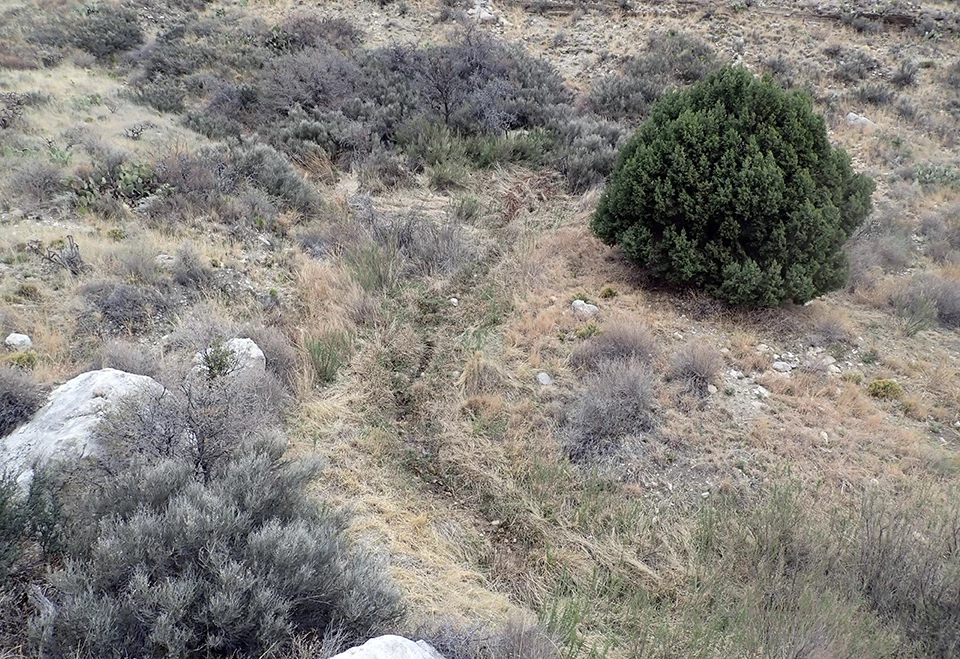
NPS
Guadalupe Spring
Guadalupe Spring (Figure 16) is a rheocrene spring (a spring that emerges as a flowing stream) located in a wash beneath the east slopes of El Capitan. The spring emerges from two orifices about 2 m apart along a hillside dense with shrubs and grasses. Flow from these orifices combines to form a channel that continues over 200 m down a gently sloped drainage, supporting dense, mat-forming grasses along the stream and several wetland plant species. The consistent flow is interspersed with shallow pools. The WY2023 visit occurred on 18 March 2023, and the spring was wetted (contained water).
Site Condition
In WY2023, we rated Guadalupe Spring (Figure 17) slightly disturbed by flow modification because there is a historical pipe (rated undisturbed to slightly disturbed in the past) and slightly disturbed by wildlife, with tracks and scat present (rated slightly to highly disturbed in the past). No other natural or human-caused disturbances were observed at Guadalupe Spring in WY2023.
As in past years, we did not observe invasive non-native crayfish or American bullfrog (Lithobates catesbeianus), and we did not observe any invasive non-native plants in WY2023.
We observed five obligate/facultative wetland plants at Guadalupe Spring in WY2023: horsetail (Equisetum sp., a forb observed in 2017–2022); maidenhair fern (Adiantum sp., a fern observed in 2018–2022); mule-fat (Baccharis salicifolia, a shrub observed in 2017–2022); a member of the rush family (Juncaceae, observed in 2019–2022); and a sedge (Carex sp., observed in 2018–2022).
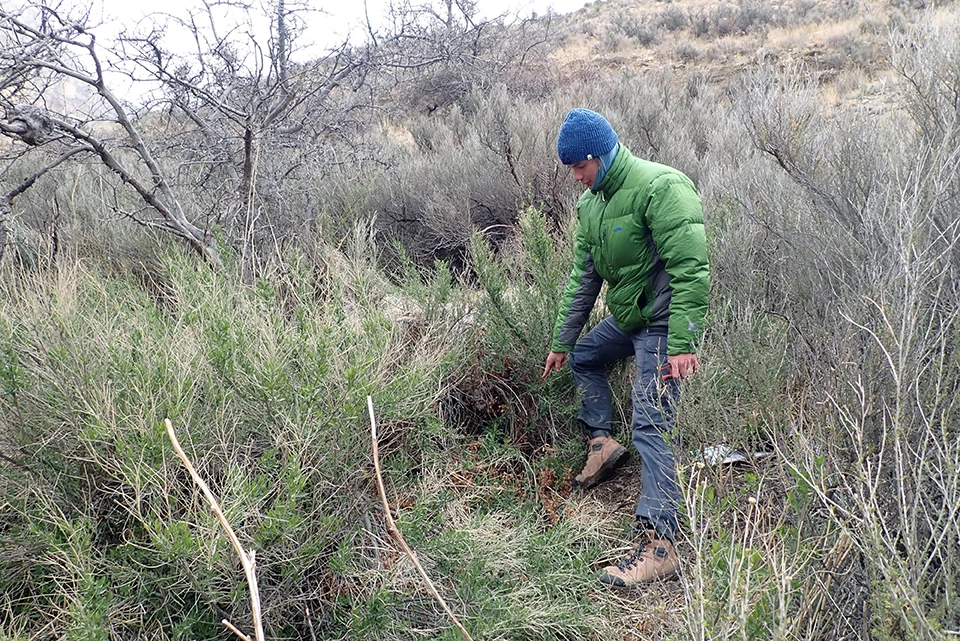
NPS
Water Quantity
Sensors are deployed and data are downloaded during our annual visit, which takes place in the middle of the water year; the dates of these visits are indicated by black diamonds in the persistence graph (Figure 18). The temperature sensor indicated that Guadalupe Spring was wetted for 169 of 169 days (100%) measured up to the WY2023 visit. In prior water years, the spring was wetted 91–100% of the days measured across entire water years.

NPS
Discharge was estimated at 24.6 ± 1.5 L/min (6.5 ± 0.4 gal/min) in WY2023, which falls within the range of values from prior years (Table 9).
Wetted extent was evaluated using a method for flowing water. The springbrook length in WY2023 was measured up to 100 m (328 ft) but total length was estimated at 200–500 m (656–1,640 ft). In the past, estimated spring brook lengths have ranged from 100–500 m (328–1,640 ft). Width and depth within the first 100 m of springbrook length averaged 65.2 cm (25.7 in), and 4.8 cm (1.9 in), respectively. In WY2023, width and length of the spring were within the ranges of previous measurements, but it was deeper than in prior years (Table 10).
Water quality
Core water quality (Table 11) and water chemistry (Table 12) data were collected at the primary sampling location at the spring orifice (Figure 17). A syringe and calibration cup were used to collect and measure the sample for core water quality and a syringe was used to collect the sample for water chemistry, which may affect our results. Values for dissolved oxygen, specific conductivity, and total dissolved solids were within the ranges of prior values, while temperature was lower than in previous years. The pH probe failed a calibration check, so pH data are not available for the WY2023 visit. Alkalinity, calcium, chloride, potassium, and sulphate values were within ranges of previous values, while magnesium was higher.
Guadalupe Spring Data Tables
| Sampling Location | WY2023 Mean (range of prior means) |
Prior Years Measured (# of visits with measurements) |
|---|---|---|
| 002 | 24.6 ± 1.5 (19.9–31.0) | 2017–2022 (5) |
| Measurement | WY2023 Value (range of prior values/means) |
Prior Years Measured (# of visits with measurements) |
|---|---|---|
| Width (cm) | 65.2 ± 42.7 (53.8–107.0) | 2017–2022 (5) |
| Depth (cm) | 4.8 ± 6.2 (1.8–3.2) | 2017–2022 (5) |
| Length (m) | 100 (100) | 2017–2022 (5) |
| Sampling Location | Measurement Location | Parameter | WY2023 Value (range of prior values) |
Prior Years Measured (# of measurements) |
|---|---|---|---|---|
| 001 | Center | Dissolved oxygen (mg/L) | 7.45 (6.34–8.35) |
2018–2022 (4) |
| 001 | Center | pH | n.d. (7.30–7.83) |
2017–2022 (5) |
| 001 | Center | Specific conductivity (µS/cm) | 727 (714–759) |
2017–2022 (5) |
| 001 | Center | Temperature (°C) | 13.7 (14.4–19.6) |
2017–2022 (7) |
| 001 | Center | Total dissolved solids (mg/L) | 472 (464–494) |
2017–2022 (5) |
| Sampling Location | Measurement Location | Parameter | WY2023 Value (range of prior values) |
Prior Years Measured (# of measurements) |
|---|---|---|---|---|
| 001 | Center | Alkalinity (CaCO3) |
235 (235–265) |
2017–2022 (5) |
| 001 | Center | Calcium (Ca) |
82 (70–110) |
2017–2022 (5) |
| 001 | Center | Chloride (Cl) |
5 (b.d.l.–170) |
2017–2022 (5) |
| 001 | Center | Magnesium (Mg) |
60 (32–50) |
2017–2022 (5) |
| 001 | Center | Potassium (K) |
0.5 (0.3–1.3) |
2017–2022 (5) |
| 001 | Center | Sulphate (SO4) |
155 (118–160) |
2017–2022 (5) |
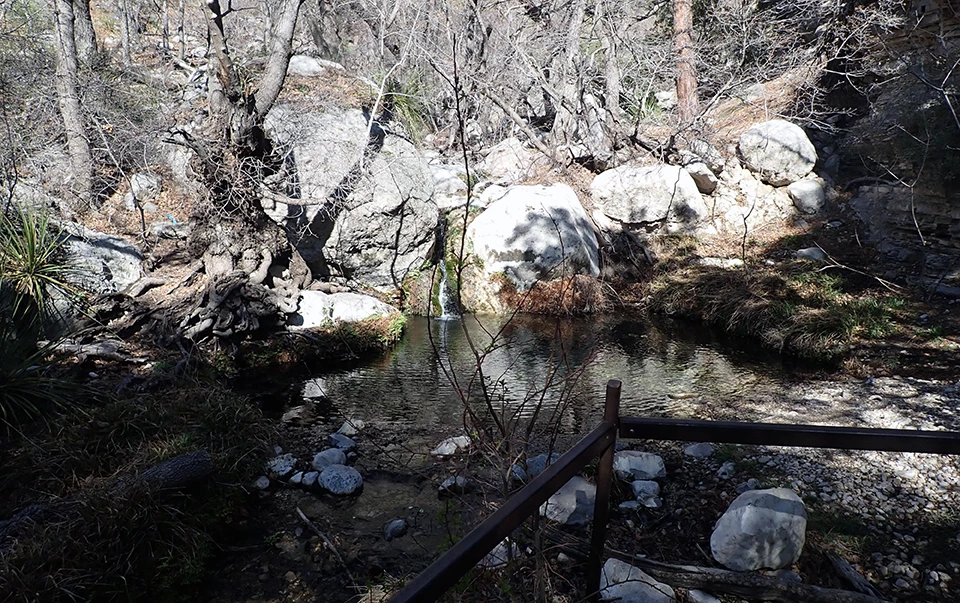
NPS
Smith Spring
Smith Spring (Figure 19) is a rheocrene spring (a spring that emerges into one or more stream channels). The spring appears from two orifices beneath boulders and cobble to form a springbrook that flows for more than 100 m in a forested drainage in the Guadalupe Mountains. The stream flow is consistent and interspersed with plunge pools, the largest of which measures 6 m across. The channel is lined with large boulders and occasional eroded and undercut banks. Wetland plants thrive along the upper portions of the system, but banks along the lower reaches have more bare and compacted soil. The WY2023 visit occurred on 20 March 2023, and the spring was wetted (contained water).
Site Condition
In WY2023, we rated Smith Spring (Figure 20) slightly disturbed by contemporary human use because of a bench, stonework, and trail leading to the spring and across the channel, which has caused compacted soil and trampled vegetation along banks downstream of the fence (rated moderately to highly disturbed in the past); slightly disturbed by drying based on the presence of upland species in the riparian area (rated undisturbed in the past); slightly disturbed by fire, with burn scars on tree trunks (rated undisturbed to slightly disturbed in the past); and moderately disturbed by hiking trails because of the Smith Spring trail, which leads directly to the spring and across the main channel (rated moderately to highly disturbed in the past). No other natural or human-caused disturbances were observed at Smith Spring in WY2023.
As in past years, we did not observe invasive non-native crayfish or American bullfrog (Lithobates catesbeianus), and we did not find any invasive non-native plants in WY2023.
We observed four obligate/facultative wetland plants at Smith Spring in WY2023: lobelia (Lobelia sp., a forb not previously observed); maidenhair fern (Adiantum sp., a fern observed in 2018–2022); a member of the rush family (Juncaceae, not previously observed); and a sedge (Carex sp., observed in 2018–2022).
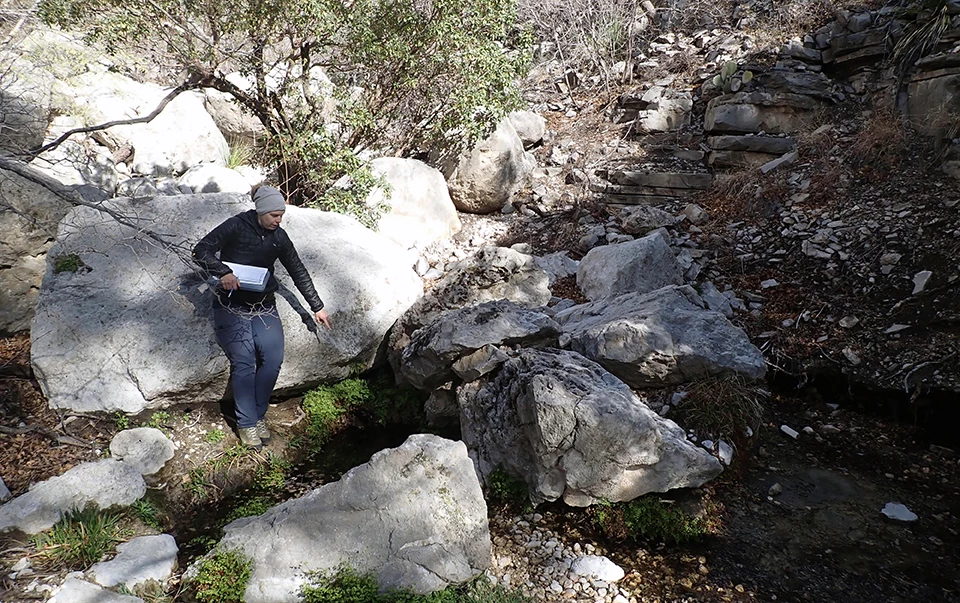
NPS
Water Quantity
Sensors are deployed and data are downloaded during our annual visit, which takes place mid-water year; the dates of these visits are indicated by black diamonds in the persistence graph (Figure 21). The temperature sensor indicated that Smith Spring was wetted for 171 of 171 days (100%) measured up to the WY2023 visit. In prior water years, the spring was wetted 99.5–100% of the days measured across entire water years.

NPS
Discharge was estimated at 330.2 ± 17.9 L/min (87.2 ± 4.7 gal/min) in WY2023. Prior values are not available for comparison because of a change in the discharge sampling location in WY2023 (Table 13).
Wetted extent was evaluated using a method for flowing water. The springbrook length in WY2023 was measured up to 100 m (328 ft) but total length was estimated to be between 100 and 200 m (328–656 ft). In the past, springbrook lengths ranged from 100 m (328 ft) to estimated lengths up to 200 m (656 ft). Width and depth within the first 100 m of springbrook length averaged 2.1 m (6.9 ft) and 2.0 cm (0.8 in), respectively. Springbrook length and mean width were similar to prior years, while mean depth was lower than previously observed (Table 14).
Water Quality
Core water quality (Table 15) and water chemistry (Table 16) data were collected at the primary orifice of Smith Spring (Figure 20). The temperature was within the range recorded in prior years. The value for dissolved oxygen was higher than the range of values observed in the past, while specific conductivity and total dissolved solids were lower. The pH probe failed a post-calibration check, so pH data are not available for the WY2023 visit. Levels of magnesium and sulphate were within previous value ranges; alkalinity, calcium, and chloride values were lower than in prior years; and potassium was higher than previously observed.
Smith Spring Data Tables
| Sampling Location | WY2023 Mean (range of prior means) |
Prior Years Measured (# of visits with measurements) |
|---|---|---|
| 011 | 330.2 ± 17.9 (n.d.) | n.d. |
| Measurement | WY2023 Value (range of prior values/means) |
Prior Years Measured (# of visits with measurements) |
|---|---|---|
| Width (m) | 2.1 ± 1.2 (1.6–2.1) | 2017–2022 (5) |
| Depth (cm) | 2.0 ± 1.6 (3.6–27.7) | 2017–2022 (5) |
| Length (m) | 100.0 (99.6–100.0) | 2017–2022 (5) |
| Sampling Location | Measurement Location | Parameter | WY2023 Value (range of prior values) |
Prior Years Measured (# of measurements) |
|---|---|---|---|---|
| 001 | Center | Dissolved oxygen (mg/L) | 7.59 (6.98–7.46) |
2018–2022 (4) |
| 001 | Center | pH | n.d. (7.24–7.68) |
2017–2022 (5) |
| 001 | Center | Specific conductivity (µS/cm) | 527 (532–535) |
2017–2022 (5) |
| 001 | Center | Temperature (°C) | 14.8 (14.5–15.1) |
2017–2022 (7) |
| 001 | Center | Total dissolved solids (mg/L) | 343 (346–348) |
2017–2022 (5) |
| Sampling Location | Measurement Location | Parameter | WY2023 Value (range of prior values) |
Prior Years Measured (# of measurements) |
|---|---|---|---|---|
| 001 | Center | Alkalinity (CaCO3) |
260 (270–330) |
2017–2022 (5) |
| 001 | Center | Calcium (Ca) |
24 (54–72) |
2017–2022 (5) |
| 001 | Center | Chloride (Cl) |
0 (2–14) |
2017–2022 (5) |
| 001 | Center | Magnesium (Mg) |
47 (23–80) |
2017–2022 (5) |
| 001 | Center | Potassium (K) |
1.4 (0.0–0.9) |
2017–2022 (5) |
| 001 | Center | Sulphate (SO4) |
3 (0–5) |
2017–2022 (5) |

NPS
Upper Pine Spring
Upper Pine Spring (Figure 22) is a rheocrene spring (a spring that emerges into one or more stream channels), appearing from two orifices inside a southeast-facing drainage near the mouth of Bear Canyon. Flow from the orifices combines to form a spring channel with multiple plunge pools that has ranged from 40 to 74 m in length in recent years. The stream is lined with boulders under a canopy of oaks, pines, and junipers. The WY2023 visit occurred on 17 March 2023, and the spring was wetted (contained water).
Site Condition
In WY2023, we rated Upper Pine Spring (Figure 23) slightly disturbed by hiking trails based on proximity to the Frijole Trail (rated undisturbed to slightly disturbed in the past); slightly disturbed by contemporary human use related to a diversion pipe at the spring (rated undisturbed in the past); slightly disturbed by flow modification because while there is an iron pipe, it is not clear if it has any current effect on flow (rated undisturbed to moderately disturbed in the past); slightly disturbed by fire, due to burn scars on trees (rated undisturbed to slightly disturbed in the past); and slightly disturbed by wildlife based on tracks (rated slightly to moderately disturbed in the past). No other natural or human-caused disturbances were observed at Upper Pine Spring in WY2023.
As in past years, we did not observe invasive non-native crayfish or American bullfrog (Lithobates catesbeianus) at Upper Pine Spring in WY2023. We observed one invasive non-native plant: scattered patches of watercress (Nasturtium officinale, 1–5 plants observed in 2017).
We observed five obligate/facultative wetland plants at Upper Pine Spring in WY2023: maidenhair fern (Adiantum sp., a fern observed in 2018–2022); a member of the rush family (Juncaceae, a rush observed in 2019–2022); sedge (Carex sp., observed in 2017–2022); a member of the sedge family (Cyperaceae, observed in 2018–2022); and spikerush (Eleocharis sp., a sedge observed in 2018–2022).
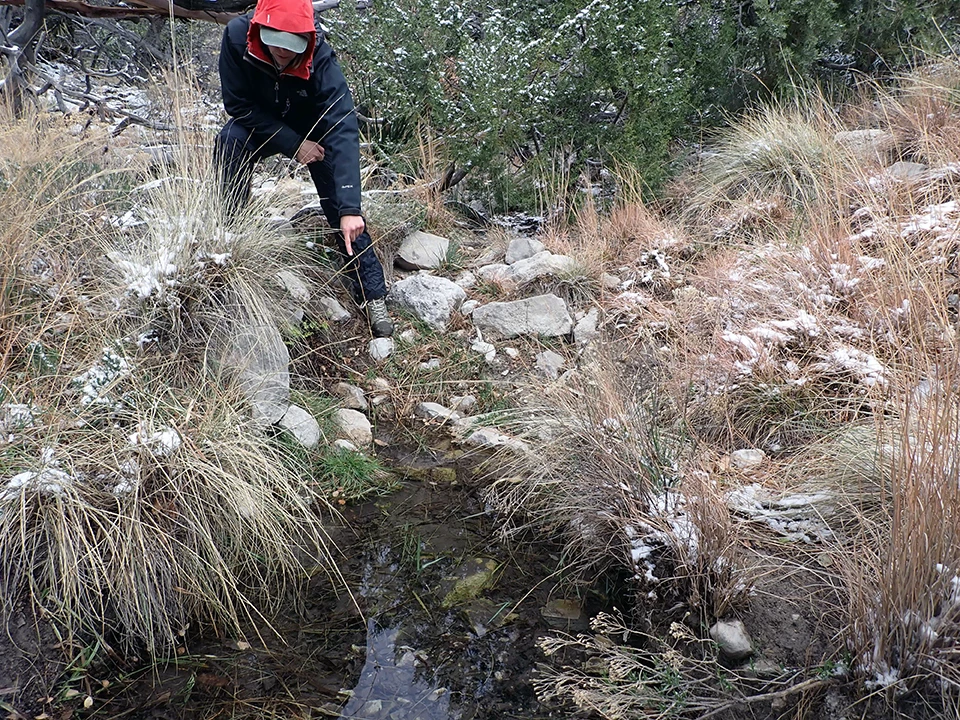
NPS
Water Quantity
Sensors are deployed and data are downloaded during our annual visit, which takes place in the middle of the water year; the dates of these visits are indicated by black diamonds in the persistence graph (Figure 24). The temperature sensor indicated that Upper Pine Spring was wetted for 168 of 168 days (100%) measured up to the WY2023 visit. In prior water years, the spring was wetted 98.9–100% of the days measured across entire water years.
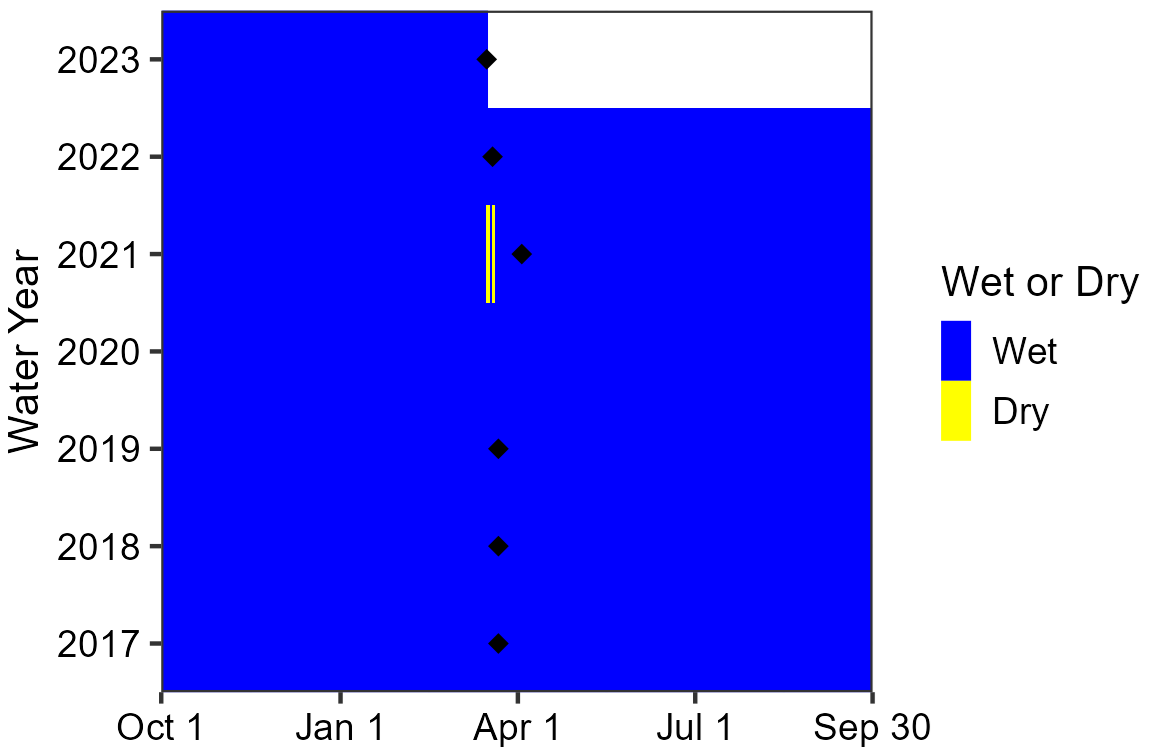
NPS
Discharge was estimated at 24.6 ± 0.6 L/min (6.5 ± 0.2 gal/min) in WY2023. Prior discharge measurements are unavailable for comparison because the sampling location was changed in WY2023 (Table 17).
Wetted extent was evaluated using a method for flowing water. In WY2023, the total springbrook length was 67.1 m (220.1 ft). In the past, springbrook lengths ranged from 40.1 to 74.4 m (131.6 to 244.1 ft). Width and depth along the springbrook averaged 70.8 cm (27.9 in) and 7.7 cm (3.0 in), respectively. The mean width, depth, and length of the springbrook were consistent with ranges of previous values (Table 18).
Water Quality
Core water quality (Table 19) and water chemistry (Table 20) data were collected at the primary sampling location at the orifice of Upper Pine Spring (Figure 23). Values for dissolved oxygen, specific conductivity, temperature, and pH were within the ranges of prior measurements while the total dissolved solids value was slightly lower than in the past. Alkalinity, chloride, magnesium, and sulphate levels were within the ranges of values recorded in prior years. The calcium value was lower than in previous years, while potassium was higher.
Upper Pine Spring Data Tables
| Sampling Location | WY2023 Mean (range of prior means) |
Prior Years Measured (# of visits with measurements) |
|---|---|---|
| 002 | 24.6 ± 0.6 (n.d.) | n.d. |
| Measurement | WY2023 Value (range of prior values/means) |
Prior Years Measured (# of visits with measurements) |
|---|---|---|
| Width (cm) | 70.8 ± 53.9 (62.0–99.6) | 2017–2022 (5) |
| Depth (cm) | 7.7 ± 8.4 (4.0–17.0) | 2017–2022 (5) |
| Length (m) | 67.1 (40.1–74.4) | 2017–2022 (5) |
| Sampling Location | Measurement Location | Parameter | WY2023 Value (range of prior values) |
Prior Years Measured (# of measurements) |
|---|---|---|---|---|
| 001 | Center | Dissolved oxygen (mg/L) | 7.37 (5.56–7.43) |
2017–2022 (5) |
| 001 | Center | pH | 7.39 (7.27–7.58) |
2017–2022 (5) |
| 001 | Center | Specific conductivity (µS/cm) | 513.0 (512.9–533.0) |
2017–2022 (5) |
| 001 | Center | Temperature (°C) | 14.2 (12.7–15.4) |
2017–2022 (7) |
| 001 | Center | Total dissolved solids (mg/L) | 333.0 (333.4–346.0) |
2017–2022 (5) |
| Sampling Location | Measurement Location | Parameter | WY2023 Value (range of prior values) |
Prior Years Measured (# of measurements) |
|---|---|---|---|---|
| 001 | Center | Alkalinity (CaCO3) |
280 (275–310) |
2017–2022 (5) |
| 001 | Center | Calcium (Ca) |
22 (52–56) |
2017–2022 (5) |
| 001 | Center | Chloride (Cl) |
5 (2–64) |
2017–2022 (5) |
| 001 | Center | Magnesium (Mg) |
60 (1–195) |
2017–2022 (5) |
| 001 | Center | Potassium (K) |
2.0 (0.0–1.2) |
2017–2022 (5) |
| 001 | Center | Sulphate (SO4) |
5 (0–10) |
2017–2022 (5) |
Report Citation
Authors: Kara Raymond, Susan Singley, Arturo Aguilar
Raymond, K., S. Singley, and A. Aguilar. 2025. Climate and Water Monitoring at Guadalupe Mountains National Park: Water Year 2023. Chihuahuan Desert Network, National Park Service, Las Cruces, New Mexico.
